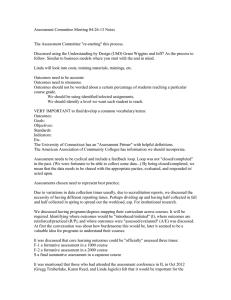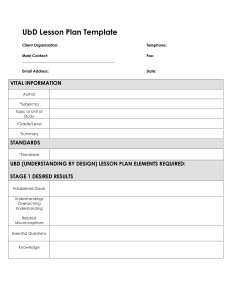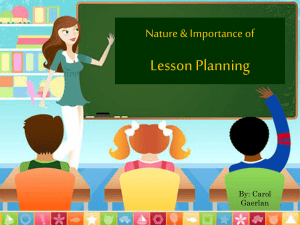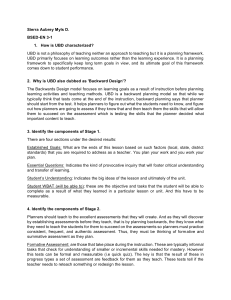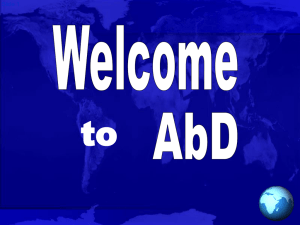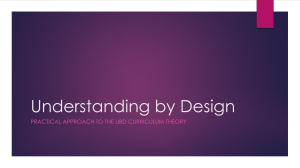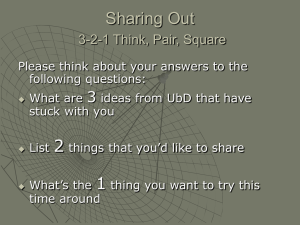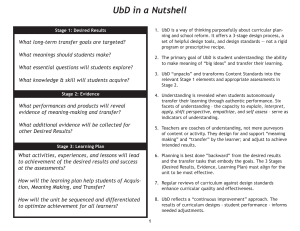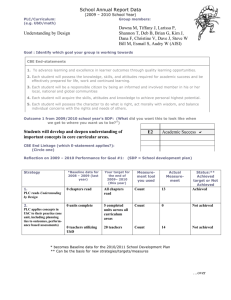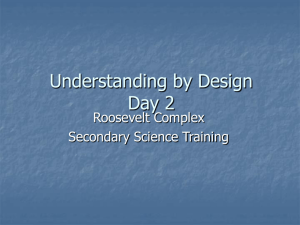The big ideas of UbD
advertisement
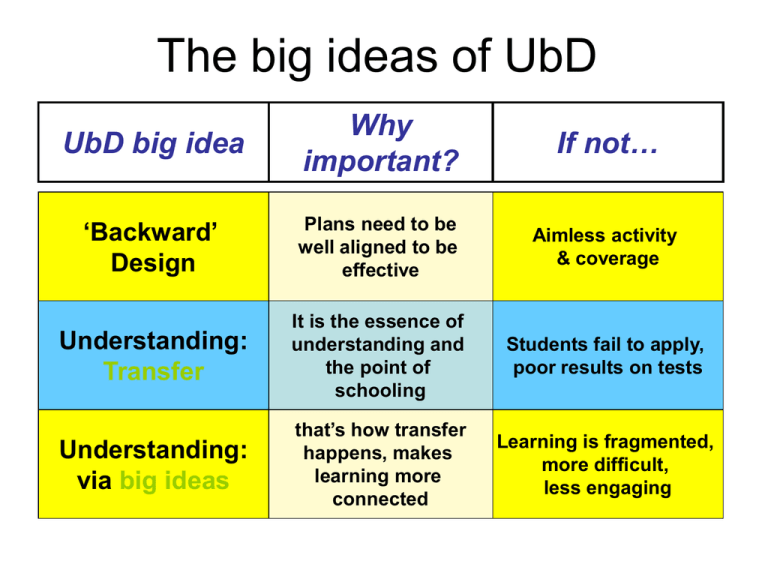
The big ideas of UbD UbD big idea Why important? If not… ‘Backward’ Design Plans need to be well aligned to be effective Aimless activity & coverage Understanding: Transfer It is the essence of understanding and the point of schooling Students fail to apply, poor results on tests Understanding: via big ideas that’s how transfer happens, makes learning more connected Learning is fragmented, more difficult, less engaging KEY: 3 Stages of (“Backward”) Design 1. Identify desired accomplishments 2. Determine acceptable evidence 3. Plan learning experiences & instruction What we typically (incorrectly) do: Identify content Without checking for alignment Brainstorm activities & methods Without checking for alignment Come up with an assessment Stage 1 Design Questions • What are the long-term transfer goals? In the end, students should be able, on their own, to...(Big Ideas) • What are the desired (enduring) understandings? (What misunderstandings must be avoided, overcome?) • What are the essential questions to be continually explored? • What knowledge & skill should they leave with? Stage 2 Design Questions • What evidence for assessment (of skills and knowledge) is required by our Stage 1 goals? • What performances are indicative of understanding - transfer of learning and understanding of content via big ideas? • What other evidence is required by the goals? • What scoring rubrics/criteria/indicators will be used to assess student work against the goals? Stage 2: Assessment • The analytic challenge is to identify the ULTIMATE tasks embodying the Standard - reflecting the kind of accomplishment the Standard envisions - and other long-term goals – What real-world important tasks epitomize the Standard? – What projects should a student who has met the Standard be able to do well? – What challenges in the world should students be prepared to handle and accomplish? Stage 3 - design Qs If those are the desired STAGE 1 goals and STAGE 2 performance tasks . . . • What do students need to acquire? • What inquiries and meaning making must they actively be made to engage in? • What transfer must they practice and get feedback on? • What formative assessments are essential for feedback, adjustment, meeting goals? • What sequence is optimal for engagement and success? • How will the work be differentiated - without sacrificing goals - to optimize success of all? WHERETO • Guidelines for Stage 3 learning design – Where is the work headed (learning goals, relevance)? – Hook and hold the learner (inquiry, research, problem solving, experimentation) – Equip with key learning & experience (experiential and inductive learning, direct instruction, homework and other) – Rethink and revise thinking/work (rehearse, refine) – Evaluate your progress (self-reflection, feedback) – Tailored to personal need, interest, profile (differentiation) – Organized for optimal learning (sequencing) Stage 3 Design • Determine what needs to be uncovered vs. covered • Test design against WHERETO • How will students demonstrate learning and understanding? (6 Facets or Bloom’s) • Diagnostic and formative assessments— preassessment (summative is Stage 2) Unit Design Cycles In-class observations Analysis of formative student work Adjust, as needed Student feedback what works, what doesn’t DESIGN, based on: • Goals/Standards • Performance gaps Pre-assess, tweak Teach it with revisions, as needed Analysis of summative student work Draft: • Stage 1 • Stage 2 • Stage 3 Design it Unit self-assessed against UbD design standards Peer and/or Expert review Misconception Alert ! •No one expects such “recipes” and “cooking” every day The aim is “gourmet” unit design work smarter, not harder: keep adding each year to a database of units: Next Steps . . . • Refer to the handouts (UbD Stages in a Nutshell, stage checklists, Observable Indicators of Teaching for Understanding, UbD Roadmap) • Use the wikispace (school homepage then click on UbD) • Try using essential questions next week • Design (a) model unit(s) individually or as grade level teams within a subject area Next cont’d . . . • Peer review those units informally or formally • Consult with the UbD trainers • Pilot those units • Use the unit to provide data for your data team • Request follow up work/consultation time individually, as grade level, cross school grade level/subject area
